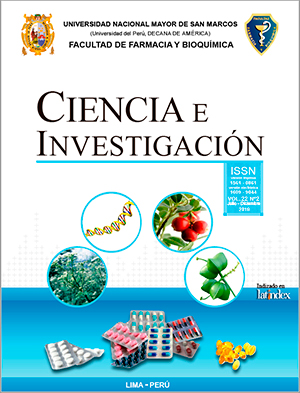Drug-related problems and therapeutic adherence in patients with tuberculosis at the Rimac Maternal and Child Health Center
DOI:
https://doi.org/10.15381/ci.v22i2.17612Keywords:
Pharmacotherapeutic follow-up, Negative Results Associated with Medication (RNM), Drug-Related Problems (PRM), Adherence to treatmentAbstract
The research aimed to determine the drug-related problems (PRM) caused by the negative results associated with the medication (NMR) and the level of treatment adherence to 12 outpatients (the age range was 3 to 64 years and whose male gender represented 58.33% and 41.67% female) with tuberculosis admitted to the tuberculosis strategy health service of the Rímac Maternal and Child Health Center, for a period of nine months, through the application of the Dader Method , PRMs were identified and the probability of adverse effects obtained the highest percentage (35.48%) among the PRMs detected, secondly, it occupied the dose, schedule and / or inappropriate duration (32.26%), thirdly it occupied the breach partial (22.58%) followed by others. 31 NMR were identified, that is, an average of 2.5 NMR per patient, 18 (58.1%) of effective NMR were detected, 12 (38.7%) of safety NMR and 1 (3.2%) of RNM of need. The RNM were associated in greater magnitude to the ineffectiveness of the treatment as first place and security was second. The pharmaceutical intervention was involved in the quantity of medications administered. The healthcare activity of the pharmacotherapeutic follow-up professional managed to identify and solve the problems related to the medications caused by the negative results associated with the medication, concretizing in the significant improvement of therapeutic adherence to the pharmacological treatment of patients with tuberculosis.
Downloads
Published
Issue
Section
License
Copyright (c) 2020 Carlos Ccencho, Norma Ramos

This work is licensed under a Creative Commons Attribution-NonCommercial-ShareAlike 4.0 International License.
LOS AUTORES RETIENEN SUS DERECHOS:
- Los autores retienen sus derechos de marca y patente, y tambien sobre cualquier proceso o procedimiento descrito en el artículo.
- Los autores retienen el derecho de compartir, copiar, distribuir, ejecutar y comunicar públicamente el articulo publicado en la Revista Ciencia e Investigación (por ejemplo, colocarlo en un repositorio institucional o publicarlo en un libro), con un reconocimiento de su publicación inicial en la Revista Ciencia e Investigación.
- Los autores retienen el derecho a hacer una posterior publicación de su trabajo, de utilizar el artículo o cualquier parte de aquel (por ejemplo: una compilación de sus trabajos, notas para conferencias, tesis, o para un libro), siempre que indiquen la fuente de publicación (autores del trabajo, revista, volumen, numero y fecha).






